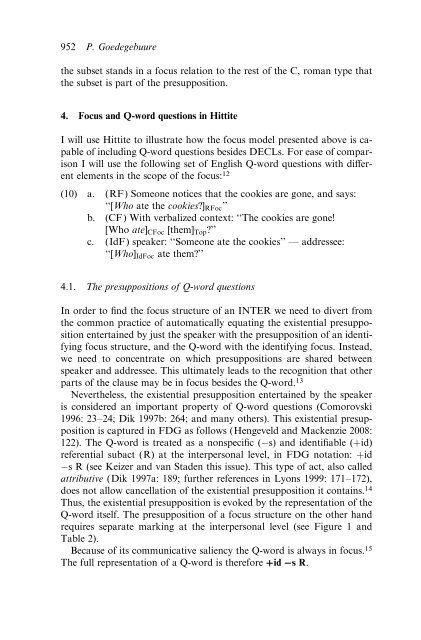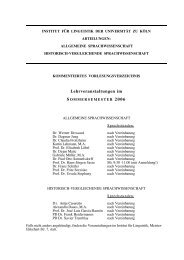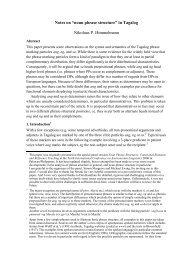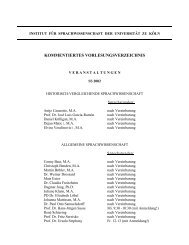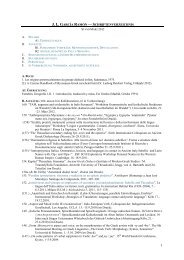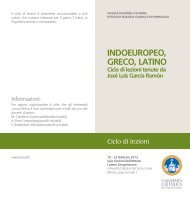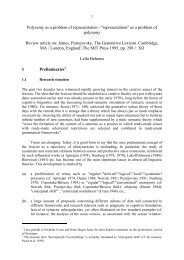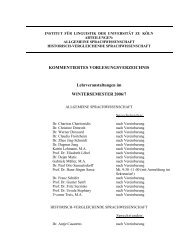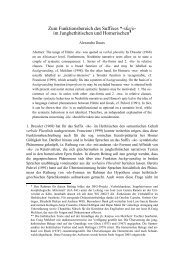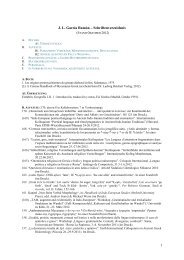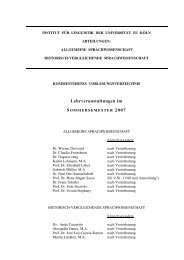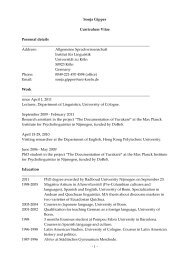Topics in Anatolian Historical Grammar Prof. Dr. H. Craig Melchert
Topics in Anatolian Historical Grammar Prof. Dr. H. Craig Melchert
Topics in Anatolian Historical Grammar Prof. Dr. H. Craig Melchert
You also want an ePaper? Increase the reach of your titles
YUMPU automatically turns print PDFs into web optimized ePapers that Google loves.
952 P. Goedegebuure<br />
the subset stands <strong>in</strong> a focus relation to the rest of the C, roman type that<br />
the subset is part of the presupposition.<br />
4. Focus and Q-word questions <strong>in</strong> Hittite<br />
I will use Hittite to illustrate how the focus model presented above is capable<br />
of <strong>in</strong>clud<strong>in</strong>g Q-word questions besides DECLs. For ease of comparison<br />
I will use the follow<strong>in</strong>g set of English Q-word questions with di¤erent<br />
elements <strong>in</strong> the scope of the focus: 12<br />
(10) a. (RF) Someone notices that the cookies are gone, and says:<br />
‘‘[Who ate the cookies?] RFoc ’’<br />
b. (CF) With verbalized context: ‘‘The cookies are gone!<br />
[Who ate] CFoc [them] Top ?’’<br />
c. (IdF) speaker: ‘‘Someone ate the cookies’’ — addressee:<br />
‘‘[Who] IdFoc ate them?’’<br />
4.1. The presuppositions of Q-word questions<br />
In order to f<strong>in</strong>d the focus structure of an INTER we need to divert from<br />
the common practice of automatically equat<strong>in</strong>g the existential presupposition<br />
enterta<strong>in</strong>ed by just the speaker with the presupposition of an identify<strong>in</strong>g<br />
focus structure, and the Q-word with the identify<strong>in</strong>g focus. Instead,<br />
we need to concentrate on which presuppositions are shared between<br />
speaker and addressee. This ultimately leads to the recognition that other<br />
parts of the clause may be <strong>in</strong> focus besides the Q-word. 13<br />
Nevertheless, the existential presupposition enterta<strong>in</strong>ed by the speaker<br />
is considered an important property of Q-word questions (Comorovski<br />
1996: 23–24; Dik 1997b: 264; and many others). This existential presupposition<br />
is captured <strong>in</strong> FDG as follows (Hengeveld and Mackenzie 2008:<br />
122). The Q-word is treated as a nonspecific ( s) and identifiable (þid)<br />
referential subact (R) at the <strong>in</strong>terpersonal level, <strong>in</strong> FDG notation: þid<br />
s R (see Keizer and van Staden this issue). This type of act, also called<br />
attributive (Dik 1997a: 189; further references <strong>in</strong> Lyons 1999: 171–172),<br />
does not allow cancellation of the existential presupposition it conta<strong>in</strong>s. 14<br />
Thus, the existential presupposition is evoked by the representation of the<br />
Q-word itself. The presupposition of a focus structure on the other hand<br />
requires separate mark<strong>in</strong>g at the <strong>in</strong>terpersonal level (see Figure 1 and<br />
Table 2).<br />
Because of its communicative saliency the Q-word is always <strong>in</strong> focus. 15<br />
The full representation of a Q-word is therefore Bid Cs R.


